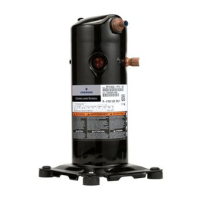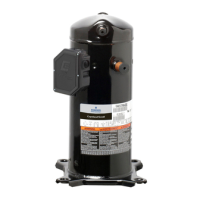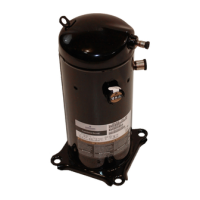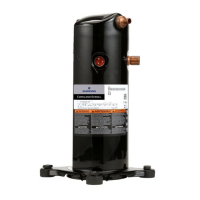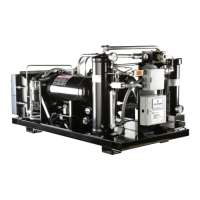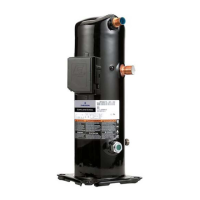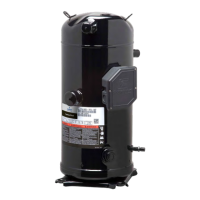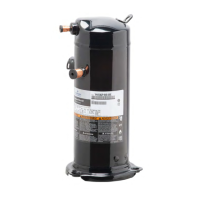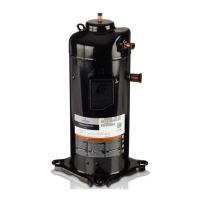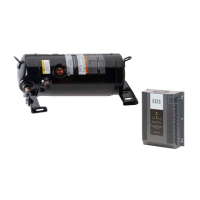5
Application Engineering
BULLETIN
AE4-1383 R5
© 2012 Emerson Climate Technologies, Inc.
Printed in the U.S.A.
ZF*K5E Low Temperature K5 Compressors for
Refrigeration
The low temperature models are provided with an
injection port that can be used for either liquid or vapor
injection.
Liquid Injection
When using the ZF*K5E scrolls for liquid injection
operation, a discharge temperature control (DTC)
valve must be applied. The purpose of the DTC valve
is to eliminate the need for a standard capillary tube.
The DTC valve is approved for all refrigerants in
this product range. A DTC valve must also be used
for ZF**K5E applications with R-407A, R-407C and
R-407F (R-407A/C/F) with vapor injection via a special
T-fi tting adapter. Further details and part numbers
related to the DTC valve are listed in Table 1 at the
end of this bulletin.
DTC Valve Specifications
The following components are not required, but they
are recommended for liquid injection.
• Sight Glass - A sight glass can be installed before
the DTC valve to allow for visual inspection for the
presence of liquid refrigerant.
• Filter/Drier - A filter/drier should be installed
upstream of the injection circuit to avoid the
possibility of the DTC screen blockage due to
contaminants.
Figures 2A through 2C are a representation of typical
systems, depicting the location of these components
Installation of DTC Valve
The valve bulb must be installed in the top cap thermal
well to adequately control scroll temperatures. The
valve should be tightened on the injection fitting to
a torque of 216-245 in. lbs. (24.4 - 27.7 Nm). A 90°
orientation on the valve is recommended, however it will
function properly in any orientation. The capillary tube
connecting the valve to the bulb should be positioned
such that it does not contact the compressor during
operation. Do not bend the capillary tube within 1”
(25.4mm) of the valve.
The DTC valve comes with an insulating cap. If this
additional height from the cap is an issue, the valve
cap could be replaced with high temperature insulation.
This should be applied to insulate and protect the valves
remote bulb assembly. This will reduce the total height
requirement by 0.5” (12.7mm).
Suggested Application Techniques for the DTC
Valve
For the most efficient thermal sensing, spread a thin film
of thermal grease around the DTC valve bulb before
installing into the top cap well. However for proper
functioning of the valve this is not required.
• For service purposes, a mechanical ball valve (not
provided by Emerson) is also recommended in the
liquid and vapor injection line.
For the liquid injection system to be effective, a
minmum of 5°F subcooled liquid at the at the DTC inlet
is required.
Note! To ensure adequate temperature control,
take care to not damage the DTC valve bulb when
installing.
Vapor Injection
The ZF*K5E 8-15 HP scrolls can also be applied with
vapor injection by implementing an economizer circuit
in the system. Economizing is accomplished by utilizing
a subcooling circuit similar to that shown in Figure 3 at
the end of this bulletin. This mode of operation increases
the refrigeration capacity and in turn the efficiency of
the system.
The schematic shows a system configuration for
the economizer cycle. A heat exchanger is used to
provide subcooling to the refrigerant before it enters
the evaporator. This subcooling process provides the
increased capacity gain for the system, as described
above. During the subcooling process a small amount
of refrigerant is evaporated and superheated. This
superheated refrigerant is then injected into the mid
compression cycle of the scroll compressor and
compressed to discharge pressure. This injected vapor
also provides cooling at higher compression ratios, similar
to liquid injection of standard ZF scroll compressors. The
benefits provided will increase as the compression ratio
increases, thus, more gains will be made in summer
when increased capacity may actually be required.
An example of the additional capacity available when
using vapor injection is depicted in the following table.
ARI Low Temperature Ratings
(-25°F/105°F, R-404A)
Model With EVI* Without EVI*
ZF34K5E 48,100 Btu/hr 34,200 Btu/hr
ZF41K5E 57,500 Btu/hr 42,200 Btu/hr
ZF49K5E 71,000 Btu/hr 50,500 Btu/hr
*
Maximum possible subcooling
* Without EVI is “0” subcooling
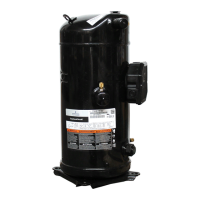
